Worn out shoes trigger pain in everything from the toes to the back and shoulders. A solid pair of walking shoes creates a foundation that fuels daily activities. Walking shoes may look similar to running shoes, but their design differs in how they support and cushion the feet. They can make such a difference in your comfort that it’s worth doing a little research to find the right pair.
Whether it’s long walks or a day’s work on your feet, comfortable walking shoes make all the difference in how you feel. Various types of walking shoes accommodate different foot types, foot issues, sizes, and widths. We reviewed six of the best men’s walking shoes on the market, including lightweight, orthotic, and recovery shoes. We’ve also included a shopping guide to help you determine the type of walking shoes that will keep you energized and on your feet.
6 Best Walking Shoes for Men of 2024
Best Walking Shoes for Men Overall
KEEN Men’s Austin
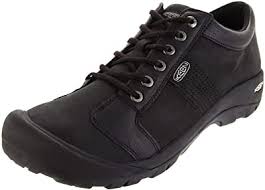
Real leather and a metatomical footbed create a durable, comfortable shoe that supports the foot for all-day wear. An oxford lace design gives them a classy look that’s ideal for urban life or even the workplace.
$125 from Keen.com
Best Walking Shoes for Men Overall: KEEN Men’s Austin
Best Lightweight Walking Shoes for Men: Men’s Oomg Low Shoe
Best Trail Walking Shoes for Men: Vasque Mantra 2.0 GTX
Best Orthotic (Arch Support) Walking Shoes for Men: ASICS Gel-Contend 5 Walker
Best Cushioned Walking Shoes for Men: Hoka One One Bondi 7
Best Recovery Walking Shoe for Men: Topo Athletic Vibe

Best Walking Shoes for Men Overall
KEEN Men’s Austin
- Made of environmentally preferred leather
- Footbed infused with probiotic technology to cut odors
- Metatomical footbed for better arch support and foot contouring
Keen doesn’t cut corners with the Austin shoes. Top of the line full-grain, nubuck leather in the uppers offers incredible durability. Keen also prides themselves on only using environmentally preferred leather. That means that the leather is made in certified tanneries that don’t use harmful chemicals in the tanning process.
Keen even uses a unique metatomical footbed. The footbed has been contoured to fit the natural curves and arch of the foot, with special emphasis on support through the arch and the first metatarsal (big toe). That focused support cushions high-pressure points while maintaining the structure of the foot’s arch even after long wear.
These walking shoes have a definite urban vibe with their classic oxford laces. They’re a shoe that works for day-to-day activities or workplaces where you’ll be on your feet all day.
“The Austin’s footbed is removable for use with aftermarket orthotic inserts.”
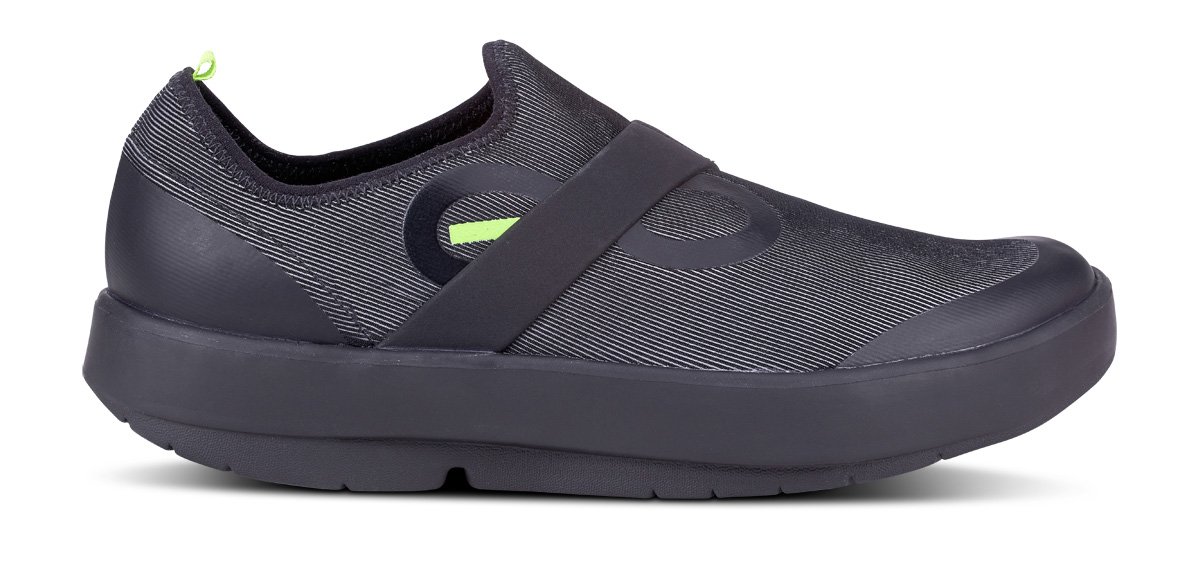
Best Lightweight Walking Shoes for Men
Men’s Oomg Low Shoe
- Oofoam absorbs impact, reducing stress on the joints
- Machine-washable design
- 4-way stretch upper fabric for a snug, custom fit
The Oomgs have an unforgettable name, and once you try them on, you won’t forget it. Oofoam technology in the soles absorbs impact to reduce the stress and tension on the joints and back. It improves recovery times and gives these shoes their light weight. A specially designed footbed cradles the foot and supports the arches to reduce foot fatigue.
Four-way stretch fabric in the upper stretches over the foot for a comfortable, custom feel. The closed-cell foams are completely machine washable. These are good walking shoes if dirt, grime, or foot odor plague you because all you have to do is toss them in the washer, and they’re ready to go again.
Tip: Measure your feet before ordering shoes online. You’ll get a better fit if you measure at the end of the day when your feet are at their largest due to swelling.
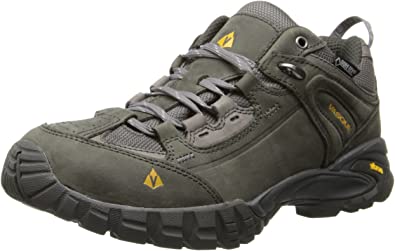
Best Trail Walking Shoes for Men
Vasque Mantra 2.0 GTX
- Durable Nubuck leather and Gore-tex mesh in the upper
- Wide toe box accommodates foot swelling during distance walks or hiking
- Good arch support
The Mantra 2.0 GTX combines some of the best outdoor technologies with traditional materials that have proved themselves over decades. Nubuck leather covers a majority of the upper, giving the shoes the durability to withstand hard trails. It’s mixed with Gore-tex, which creates a waterproof membrane, yet it allows water to evaporate within the shoes, so the feet don’t overheat.
The Vibram outsole provides excellent traction that’s designed for a wide range of terrains. A wide toe box makes this a comfortable fit for most people, but it might leave a little too much room if you have narrow feet. The high-quality materials make these some of the best hiking shoes available. The Mantra 2.0 GTX will take you miles and miles over city streets or mountain trails and still leave your feet happy.
Tip: You should be able to wiggle your toes inside the shoe. There should also be about a half an inch between the toes and the end of the shoe. If you can’t wiggle your toes at all, you may have the wrong size, or the shoe’s design may be too narrow for your feet.
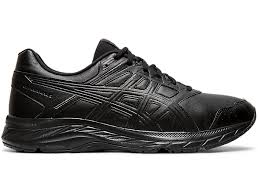
Best Orthotic (Arch Support) Walking Shoes for Men
ASICS Gel-Contend 5 Walker
- Extra-wide design accommodates swelling and larger feet
- AMPLIFOAM midsole provides comfortable arch support
- Internal heel counter holds the foot in place for correct foot positioning
Wide feet will love the Gel-Contender 5 Walker. An extra-wide toe box gives wide feet all of the wiggle room they’ll need. However, this shoe also includes excellent arch support with an AMPLIFOAM midsole. The foam cushions but creates a neutral footbed for all-day comfort.
ASICS uses a gel foam in the heel for extra cushioning, making these shoes a great casual shoe for long days on your feet. These are also a great pair of shoes for running if you want a shoe that can transition between activities.
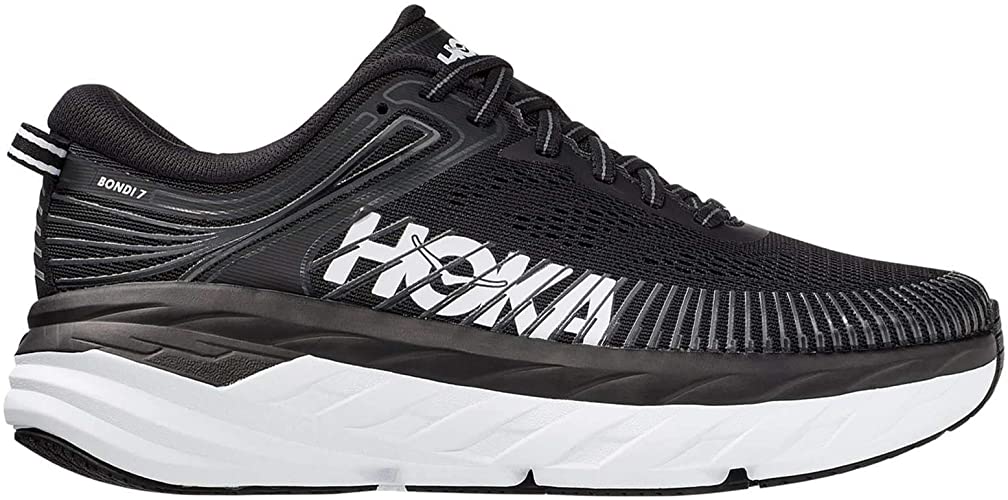
Best Cushioned Walking Shoes for Men
Hoka One One Bondi 7
- EVA midsole cushions and supports the arch
- Internal heel counter holds the foot in place and reduces sliding in the shoe
- Works for daily wear, running, or trails
One look at the Bondi 7 and you know there’s more cushioning than you’ve ever experienced before. You’ve got enough comfort for walking on pavement or trails, and your feet will still be happy. Considering how much cushioning they have, they have a relatively neutral offset of four millimeters, so you’re not walking on your toes.
An EVA foam midsole provides support through the arch. Internal heel counters lock the foot in place, so you’re not slipping and sliding over all that cushioning. A breathable mesh upper prevents overheating and provides a snug, comfortable fit. Finally, these shoes have received an award from the American Podiatric Medical Association as a product that promotes healthy foot function.
“The Bondi 7’s heel cushioning cradles the Achilles in soft comfort.”
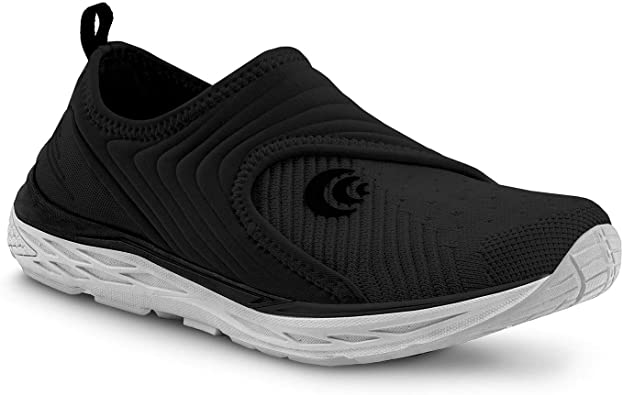
Best Recovery Walking Shoe for Men
Topo Athletic Vibe
- Slip-on design for easy entry and removal
- Ridged footbed massages and stimulates the bottom of the foot
- Roomy toe box accommodates swollen, post-workout feet
The Vibe works as a comfortable daily shoe or a recovery option after hard workouts or on your active recovery day. The footbed has a wave design that stimulates the bottom of the feet to ease aches and pains with each step. It’s designed to be worn without socks, so that foot stimulation directly reaches the nerve endings. However, the footbed is antimicrobial to cut down on stinky bacteria.
The Vibe also features a wide toe box to leave space for tired, swollen feet. While the fit is snug, the engineered-knit upper stretches to comfortably cradle the foot. At a low 8.2 ounces, the Vibe gives your body a break. You’re definitely not carrying around any extra weight, which further promotes recovery.
Know Your Arch and Foot Type
Feet aren’t all made the same. They can be narrow or wide, high arched or flat. To get a good, comfortable fit, you have to take into account your unique foot characteristics and features.
| Low/Flat Arch | Low arch or flat feet aren’t all the same. There are varying degrees of flat-footedness, which can cause a tight Achilles and other foot issues. In general, a low or flat arch causes more foot movement throughout the shoe. Shoes with an orthotic can help as can designs with guard rails and other motion control features. For some people, a shoe with a flat footbed that better fits the natural arch can reduce movement and improve comfort. |
| Neutral Arch | A neutral arch is the sweet spot. It’s neither too high nor too low and fits well in a shoe with a semi-curved footbed. Most people with a neutral arch need mid-range support and stability, which makes it easier to find a comfortable shoe since most shoes fit that description. You don’t generally need extra cushioning or stability features to maintain a healthy gait. |
| High Arch | At the opposite end of the spectrum from a flat foot is the high arch. High arches need extra support because they don’t absorb impact very well. Without enough support, you can experience muscle and joint discomfort. A shoe with firm arch support and motion control work well. Those with high arches may want to look for a shoe with a removable insole, so you can use an after-market orthotic insert. |
| Narrow | Men tend to have wider feet, but everyone isn’t made from the same mold. If you have a narrow foot, you’ll notice your foot, especially the toes, slipping and sliding throughout the shoe. Look for a narrower toe box and internal heel counters to lock the foot in place. Some manufacturers have a last (the mold they use to design their shoes) with a narrower design, so you may find a particular brand that better fits the natural shape of your foot. |
| Wide | Men’s shoes are typically designed with a wider toe box than a woman’s model, but there are men’s shoes that come in wide or extra-wide designs as well. If your feet fall into that category, shoes with extra room in the toe box will prevent rubbing and chafing. No matter your foot width, you should be able to wiggle your toes a little bit. |
Walking Shoe Features to Consider
Walking shoes are made in a wide variety of materials and features like extra ankle support, memory foam footbeds, or slip-resistant soles. Your foot type and personal comfort preferences play a big role in the kind of features that make a shoe comfortable to you.
| Sole Flexibility | Walking shoes generally have a stiffer sole in comparison to running shoes because the foot doesn’t need to flex as much while walking. If you bend the toe of the shoe toward the entry, there should be some flex but not so much that the toe nears the entry. You should feel some resistance and stiffness. This resistance is what will support your foot on long-distance walks and over rough terrain. |
| Stability | Shoes typically come in one of three stability options—neutral, stability, or motion control. Neutral stability doesn’t offer any extra help to stabilize the foot within the shoe. These shoes work well for people with neutral arches since they generally have a healthy gait. Stability shoes usually have guard rails or other features that reduce side-to-side motion. If you have an inward roll of the ankle, these are the best walking shoes for you because they keep your foot in a natural position throughout the foot strike. Motion-control shoes are fairly specialized and provide the next level in stability. They feature a medial post in the arch, stiff heel, and dense foam throughout the shoe to cut down on the side-to-side movement. They also correct overpronation (the inward rolling of the ankle). |
| Weight | Heavy shoes can increase fatigue over time. Hikers, long-distance walkers, and people who are on their feet all day should take a good look at the shoe’s weight before buying. Today, there are many lightweight shoes that weigh less than a pound. They should still have adequate flexibility, cushioning, and stability for your foot type. |
| Tread/Lugs | Walking on pavement and city streets doesn’t require as much traction as hitting the trails. Deep, large lugs provide the best traction because they grip tree roots, rocks, and other debris. Trail runners typically have deeper traction, so you don’t slip and slide. However, if your daily routine includes a walk on a paved trail or through the city, you probably don’t need deep lugs, which can pick up debris. That might be fine on the trail, but it gets annoying when you’re picking rocks out of your shoes every time you head indoors. A good traction pattern provides adequate traction in an urban environment. |
| Width/Toe Box Size | The right pair of walking shoes have a toe box that leaves you a little bit of wiggle room. You don’t want to slide around in the shoe, but if your toes can’t move, they may get uncomfortable once your feet start to swell. |
| Breathability and Materials | Breathability and materials are interconnected. Materials that add durability or waterproofing like natural leather, Gore-tex, and suede may not have the best breathability. A shoe upper with a mix of materials usually offers a good balance between breathability and durability. However, if durability and waterproofing are your number one concern, skip too much mesh and opt for leather or suede mixed with Gore-tex inserts. |
| Offset (Heel-to-toe Drop) | The difference in height from the shoe’s heel to the toe is the offset or the heel-to-toe drop. A high heel-to-toe drop, ten millimeters or more, causes the heel to strike first. A shoe with this kind of design typically has extra cushioning in the heel. However, when walking, most people strike with their heel first anyway, so a walking shoe with a high offset can still be comfortable. However, if the offset is so high that it makes you feel like you’re walking on your toes or your toes start to go numb, it’s too high. Minimalist shoes typically have an offset below four millimeters. This type of shoe won’t provide enough support or cushioning for most people. A mid-range offset between four to nine millimeters is comfortable for most people. |
| Foot Issues | Corns, bunions, and calluses may influence the type of shoe that feels comfortable to you. Shoes with extra width can often accommodate these types of foot issues. If plantar fasciitis plagues you, look for a shoe with extra support throughout the footbed, from the toes to the Achilles. Anatomical arch support and a stretchy upper that helps hold the foot in place can help. |
Frequently Asked Questions
What’s the difference between a running shoe and a walking shoe?
Walking and running shoes look nearly identical. However, they have some key differences that make them better for their respective activities. The sole of a walking shoe is usually stiffer since the foot doesn’t have to flex as much while walking. If there’s too much flexibility in a walking shoe, it can fatigue the foot faster because the muscles in the foot have to work harder. Walking shoes may also have a higher offset with more cushioning in the heel because the heel strikes first when walking.
Running shoes have more flexibility in the sole and a different cushion distribution to account for the stress of running. Runners typically have a mid-foot strike versus a heel strike, so the design of the shoe offers reinforced support and cushioning throughout the footbed rather than extra in the heel. However, some people heel strike when they run too, so there are running shoes with hefty heel cushioning as well.
Can I wear orthotics in my walking shoes?
Shoes with a removable insole work best with orthotic inserts. Simply remove the insole and insert the orthotic, and the shoe is ready for wear. Some shoes have built-in orthotics, so you may be able to skip inserts altogether.
When should I replace my walking shoes?
Walking shoes wear out after 350 to 500 miles. The time it takes you to wear out the shoes will depend on the shoe type, the kind of walking you do, how often you walk, and your size. Look for signs of aging like worn tread, torn mesh, wrinkles, and other imperfections that don’t disappear after wearing them. If your feet or knees start hurting, old worn-out shoes could be the problem.
Final Advice
A comfortable walking shoe can make all the difference in how you feel at the end of the day. Every foot is different, so look for a shoe that’s comfortable for you and works with the kind of daily activities you do most.


